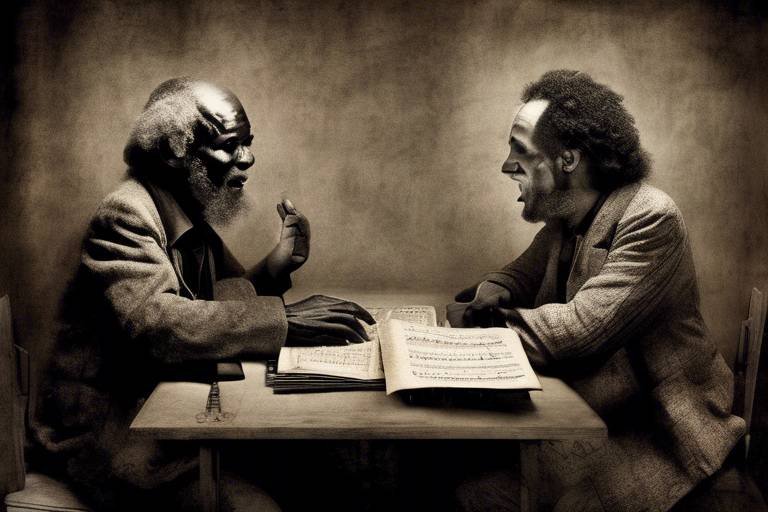Exploring the Philosophy of Evil
Welcome to the intriguing world of evil! It's a concept that has perplexed humanity for centuries, sparking debates among philosophers, theologians, and everyday people alike. What is evil? Is it an inherent part of human nature, or is it a construct shaped by societal norms? In this article, we will journey through the complex nature of evil, examining its philosophical implications, historical perspectives, and various interpretations across cultures and religions. We aim to uncover the essence of evil and its profound impact on humanity.
Understanding what constitutes evil is fundamental to philosophical inquiry. Some argue that evil is a moral absolute, a clear distinction between right and wrong that transcends cultural boundaries. Others contend that it is a relative concept, shaped by individual beliefs and societal norms. This section explores various definitions and theories, shedding light on the essence of evil in human experience. For instance, moral absolutism posits that certain actions are universally evil, regardless of context, while moral relativism suggests that what is considered evil can vary significantly across different cultures and societies.
Throughout history, different cultures have interpreted evil in unique ways. From ancient philosophies to modern religious doctrines, these interpretations have significantly influenced contemporary thought regarding the nature of evil. For example, ancient Greek philosophers like Plato and Aristotle viewed evil as a deficiency of good, while religious traditions often personify evil as a malevolent force. This section reviews key historical viewpoints, illustrating how our understanding of evil has evolved over time.
Many religions provide frameworks for understanding evil. Major faiths such as Christianity, Islam, and Buddhism conceptualize evil in ways that reflect their core beliefs and teachings. In Christianity, evil is often linked to the concept of sin, portraying it as a deviation from God's will. In contrast, Islam views evil as a test of faith, presenting it as a challenge that believers must navigate. Buddhism, on the other hand, links evil to ignorance and attachment, emphasizing the importance of enlightenment in overcoming it. These interpretations shape not only religious practices but also moral dilemmas faced by adherents.
Christianity often portrays evil in terms of sin and moral failure. The theological perspective on original sin, the devil, and the ongoing struggle between good and evil in human life underscores the belief that evil is an active force in the world. This part discusses how the narrative of the Garden of Eden symbolizes humanity's fall from grace, illustrating the pervasive nature of sin. Furthermore, the concept of the devil as a tempter serves to highlight the internal conflicts individuals face when grappling with moral choices.
Eastern philosophies, including Hinduism and Buddhism, present a different view on evil, often linking it to ignorance and attachment. In Hinduism, the cycle of rebirth is influenced by one's actions (karma), where evil deeds lead to suffering in future lives. Buddhism emphasizes the Four Noble Truths, teaching that suffering arises from desire and ignorance, positioning evil as a misunderstanding of reality. This section explores these interpretations and their implications for personal growth and enlightenment, suggesting that overcoming evil is less about battling external forces and more about internal transformation.
Philosophers have long debated the nature of evil, contributing to our understanding of this complex concept. Key theories from prominent thinkers provide insight into how evil is perceived. For instance, Immanuel Kant's notion of moral evil focuses on the intention behind actions, arguing that evil arises when individuals choose to act against their moral duties. Friedrich Nietzsche, on the other hand, presents a more radical perspective, suggesting that the will to power can manifest as evil when it seeks domination over others. These philosophical explorations challenge us to reflect on our own beliefs about what constitutes evil and why.
The psychological underpinnings of evil behavior offer insight into human nature. Understanding the factors that lead individuals to commit acts deemed evil is crucial in grappling with this concept. Social, environmental, and psychological influences play significant roles in shaping behavior. For example, groupthink can lead individuals to conform to harmful actions, while authority figures may encourage behaviors that individuals would typically find reprehensible. By examining these influences, we can better understand the complexities of human behavior and the conditions that foster evil actions.
Social dynamics can significantly impact individual behavior. The phenomenon of groupthink illustrates how collective decision-making can lead to poor moral choices, as individuals suppress dissenting opinions to maintain harmony. Additionally, authority figures can exert a powerful influence, often leading individuals to commit acts they would otherwise consider wrong. Societal norms also shape perceptions of evil, creating an environment where certain behaviors are normalized or even celebrated. This part explores how these factors contribute to the manifestation of evil actions in various contexts.
Analyzing specific historical and contemporary cases of evil can provide clarity on its manifestation. Notable examples, such as the Holocaust or acts of terrorism, reveal the motivations and circumstances that drive individuals or groups to commit heinous acts. By exploring these case studies, we can gain a deeper understanding of the psychological, social, and cultural factors that contribute to evil behavior, allowing us to reflect on the broader implications for humanity.
- What is the definition of evil? Evil is often defined as a profound immorality, wickedness, or wrongdoing that causes harm to others.
- Is evil inherent in human nature? Philosophers and psychologists debate this; some argue that humans have an innate capacity for evil, while others believe it is shaped by societal influences.
- How do different cultures perceive evil? Interpretations of evil vary widely across cultures, influenced by religious beliefs, historical contexts, and social norms.
- Can evil be justified? This is a contentious issue, as some argue that certain actions deemed evil may be justified under specific circumstances, while others maintain that evil is never justifiable.

The Nature of Evil
Understanding what constitutes evil is fundamental to philosophical inquiry. It’s a question that has puzzled humanity for centuries: What makes an action evil? Is it the intent behind the action, the consequences that follow, or perhaps a combination of both? To dive into this complex nature, we must first explore various definitions and theories surrounding evil. Some philosophers argue from a standpoint of moral absolutism, suggesting that certain actions are inherently evil regardless of context. Others lean towards moral relativism, positing that what is considered evil can vary based on cultural, social, or personal perspectives.
At its core, evil often evokes a visceral reaction. When we hear the term, images of atrocities, betrayal, and malice flood our minds. But is evil merely the absence of good, or is it a force in its own right? This leads us to consider the essence of evil in human experience. For instance, the philosopher Immanuel Kant proposed that evil can manifest through the violation of moral laws, thus framing it within the context of duty and ethics. In contrast, Friedrich Nietzsche viewed evil as a construct of societal norms, suggesting that the “will to power” could lead individuals to redefine what is deemed evil.
Moreover, the psychological aspect of evil cannot be overlooked. What drives a person to commit acts that society labels as evil? Some psychological theories suggest that innate traits, such as aggression or a lack of empathy, could foster evil behavior. Others argue that environmental factors, such as trauma or societal pressures, play a significant role in shaping one's moral compass. The interplay between these elements creates a rich tapestry of understanding, making it clear that evil is not a one-dimensional concept.
To further illustrate the complexity of evil, let’s consider a few key perspectives:
- Moral Absolutism: The belief that certain actions are universally evil, regardless of context.
- Moral Relativism: The idea that definitions of evil can change based on cultural or societal norms.
- Psychological Theories: The exploration of innate traits and environmental influences that contribute to evil behavior.
Ultimately, the nature of evil is a multifaceted enigma that intertwines philosophy, psychology, and ethics. It challenges us to reflect on our moral beliefs and confront the uncomfortable realities of human behavior. As we navigate through this philosophical labyrinth, one must ask: Are we inherently good, with the potential for evil, or are we inherently evil, with the potential for good? The answer may lie in our willingness to engage with the complexities of our own nature.

Historical Perspectives on Evil
Throughout the annals of history, the concept of evil has been interpreted through various lenses, reflecting the cultural, social, and religious contexts of different eras. From ancient civilizations to modern societies, the understanding of what constitutes evil has evolved, often shaped by prevailing philosophies and the collective consciousness of humanity. To grasp the essence of evil as perceived through history, we must delve into the rich tapestry of human thought and experience.
In ancient times, evil was frequently attributed to supernatural forces, often embodied in the form of malevolent deities or spirits. For instance, in ancient Mesopotamia, the chaos represented by Tiamat was seen as a fundamental evil that the gods had to overcome to create order. Similarly, in ancient Egypt, the concept of Ma'at represented truth and order, while its opposite, Isfet, symbolized chaos and evil. This duality illustrates how early cultures grappled with the idea of evil as an external force, one that was often beyond human control.
As societies progressed, philosophical thought began to influence interpretations of evil. The Greeks, particularly through the works of Plato and Aristotle, started to view evil not merely as an external entity but as a deficiency of good. Plato's allegory of the cave, for instance, suggests that ignorance, rather than inherent malice, is the root of evil actions. This shift towards a more internalized understanding of evil paved the way for later thinkers to explore the moral implications of human behavior.
Religious doctrines also played a pivotal role in shaping historical perspectives on evil. In Christianity, the narrative of original sin introduced the idea of an inherent flaw within humanity, suggesting that evil is part of the human condition. The theological debates surrounding the nature of evil, particularly during the Middle Ages, led to a deeper exploration of the devil's role in tempting humanity. This period saw the emergence of the idea that evil is not just an absence of good but a force actively working against divine order.
In contrast, Eastern philosophies approached evil from a different angle. Hinduism and Buddhism, for instance, often link evil to ignorance and attachment. In Hinduism, the concept of Maya (illusion) suggests that the material world can lead individuals astray, while Buddhism teaches that suffering arises from desire and attachment, which can be seen as the root of evil actions. This perspective emphasizes personal responsibility and the potential for enlightenment, highlighting a path towards overcoming evil through self-awareness and spiritual growth.
As we move into the modern era, the Enlightenment brought about a rational approach to understanding evil. Thinkers like Immanuel Kant argued that evil arises from a failure to act according to moral law, framing it as a choice rather than an inherent trait. This philosophical shift allowed for a more nuanced understanding of human agency and responsibility, urging individuals to reflect on their moral choices.
The 20th century further complicated the discourse on evil, particularly in light of the atrocities witnessed during both World Wars. The Holocaust and other genocides prompted philosophers such as Hannah Arendt to explore the banality of evil, suggesting that ordinary individuals could commit heinous acts under certain social and political conditions. This notion challenges the idea that evil is solely the domain of monstrous figures, instead presenting it as a potential within us all, influenced by our environments and societal structures.
In conclusion, the historical perspectives on evil reveal a dynamic interplay between cultural beliefs, religious teachings, and philosophical inquiries. From ancient myths to modern existential debates, our understanding of evil continues to evolve, prompting us to reflect on our moral compass and the complexities of human nature. As we navigate this intricate landscape, we must remain vigilant in recognizing the manifestations of evil in our world and strive towards a deeper understanding of its roots.
- What is the philosophical definition of evil?
Philosophically, evil is often defined as the absence or negation of good. It can also be seen as a moral failing or a choice that contradicts ethical principles. - How do different religions view evil?
Religions interpret evil in various ways; for instance, Christianity sees it as sin and moral failure, while Hinduism and Buddhism link it to ignorance and attachment. - Can evil be inherent in human nature?
This is a debated topic. Some philosophies argue that evil is a choice, while others suggest that it may be an inherent aspect of human nature influenced by external factors. - What role does society play in shaping our understanding of evil?
Society influences perceptions of evil through cultural norms, historical events, and collective experiences, often affecting individual behavior and moral judgments.

Religious Interpretations of Evil
When we dive into the realm of , we find ourselves navigating a rich tapestry of beliefs and doctrines. Different faiths offer unique lenses through which to view the concept of evil, shaping our understanding of morality and human existence. For instance, in Christianity, evil is often associated with sin and the moral failures of humanity. This perspective is deeply rooted in the notion of original sin, where the actions of Adam and Eve in the Garden of Eden introduced evil into the world. The story serves as a cautionary tale, illustrating the struggle between good and evil that persists in human life.
On the other hand, Islam presents a nuanced view of evil, often framing it as a test from Allah. In this context, evil acts are seen as opportunities for believers to demonstrate their faith and resilience. The Quran emphasizes that while evil exists, it is ultimately a part of Allah's divine plan, allowing for the growth and development of the soul. This belief fosters a sense of hope and purpose, encouraging individuals to rise above their challenges.
Buddhism, contrastingly, approaches evil from a psychological perspective, linking it to ignorance and attachment. In this framework, evil is not an inherent trait but rather a product of our misunderstandings and desires. The Four Noble Truths and the Eightfold Path serve as guides for overcoming these attachments, leading to enlightenment and the cessation of suffering. This interpretation highlights the importance of personal growth and self-awareness in combating the forces of evil within oneself.
To better illustrate these varying interpretations, consider the following table summarizing key religious perspectives on evil:
| Religion | Interpretation of Evil | Key Concepts |
|---|---|---|
| Christianity | Evil as sin and moral failure | Original sin, the devil, free will |
| Islam | Evil as a test from Allah | Divine plan, faith, resilience |
| Buddhism | Evil as ignorance and attachment | Four Noble Truths, Eightfold Path |
In summary, religious interpretations of evil provide a fascinating glimpse into how various cultures understand morality and human behavior. Each faith offers a distinct narrative that helps adherents navigate the complexities of life, emphasizing the need for personal responsibility, understanding, and growth. Whether it is through the lens of sin and redemption in Christianity, the tests of faith in Islam, or the journey towards enlightenment in Buddhism, the exploration of evil remains a profound aspect of religious thought.
- What is the origin of evil in religious texts?
Many religious texts attribute the origin of evil to the actions of humans, such as the story of Adam and Eve in Christianity, while others view it as a necessary aspect of life that tests faith. - How do different religions propose overcoming evil?
Religions propose various methods, including repentance and faith in Christianity, patience and perseverance in Islam, and mindfulness and understanding in Buddhism. - Is evil considered a part of human nature?
Some religions argue that evil is an intrinsic part of human nature, while others suggest it is a result of ignorance or external influences.

Christian Views on Evil
Christianity has long grappled with the concept of evil, framing it primarily through the lens of sin and moral failure. At its core, evil is often seen as a deviation from the divine will of God, manifesting in actions and thoughts that oppose the goodness inherent in creation. This perspective is rooted in the belief that God is wholly good, and thus, anything contrary to His nature is considered evil. The theological discourse surrounding evil is rich and multifaceted, often drawing from biblical narratives and teachings.
One of the foundational concepts in Christian theology is the notion of original sin, which posits that humanity inherited a sinful nature from Adam and Eve's disobedience in the Garden of Eden. This event is pivotal in understanding the Christian view of evil, as it introduces the idea that all humans are born with a propensity to sin. Consequently, the struggle between good and evil is not merely external but also internal, as individuals battle their sinful inclinations throughout their lives.
Moreover, the figure of the devil plays a crucial role in Christian thought about evil. Often depicted as the embodiment of evil, the devil tempts individuals away from righteousness, seeking to lead them astray. This adversarial force is not just a mythological figure but represents the real struggles Christians face in their daily lives. The New Testament, particularly in the writings of Paul, emphasizes the spiritual warfare believers engage in, highlighting the constant battle against evil influences.
In understanding evil, Christians also reflect on the concept of free will. The belief is that God granted humanity the ability to choose between good and evil, which is essential for genuine love and moral responsibility. However, this freedom also opens the door to the potential for evil actions. As such, the presence of evil is often interpreted as a consequence of humanity's misuse of free will, leading to moral failures and societal injustices.
Throughout history, Christian thinkers have developed various frameworks to understand and combat evil. For instance, thinkers like Augustine and Aquinas have contributed significantly to the discourse, arguing that evil is not a substance in itself but rather a corruption or absence of good. This philosophical approach helps to reconcile the existence of evil with the belief in a benevolent God, suggesting that evil can serve a purpose in the grand narrative of salvation and redemption.
In summary, the Christian view of evil encompasses a complex interplay of sin, free will, and the ongoing struggle against malevolent forces. It invites believers to engage deeply with their moral choices and the implications of those choices in their relationship with God and others. This understanding not only shapes individual lives but also informs the broader moral framework within which Christian communities operate.
- What is the origin of evil in Christian theology?
The origin of evil is often traced back to the concept of original sin, stemming from the disobedience of Adam and Eve in the Garden of Eden.
- How does Christianity explain the presence of evil in the world?
Christianity explains the presence of evil through the misuse of free will by humanity, allowing for sin and moral failure to occur.
- What role does the devil play in Christian views of evil?
The devil is seen as the embodiment of evil, actively tempting individuals away from God and righteousness.
- Can evil serve a purpose in Christian belief?
Some theologians argue that evil can serve a purpose in the context of God's overarching plan for redemption and salvation.

Eastern Philosophies and Evil
When we dive into the rich tapestry of Eastern philosophies, we find that the concept of evil is often viewed through a lens that emphasizes understanding and personal growth rather than mere condemnation. In traditions such as Hinduism and Buddhism, evil is intricately linked to human ignorance and attachment, suggesting that our struggles with evil stem from a lack of awareness and understanding of our true nature.
In Hinduism, the notion of evil is often associated with adharma, or actions that go against the cosmic order. This perspective posits that evil arises when individuals stray from their duties and responsibilities, leading to chaos and suffering. The stories of deities battling evil forces, such as the epic tales of Rama and Ravana in the Ramayana, illustrate the eternal conflict between good and evil, but also highlight the potential for redemption and learning. It’s a reminder that evil is not a permanent state but a phase that can be overcome through wisdom and righteous action.
On the other hand, Buddhism offers a unique interpretation of evil, often framing it as a result of ignorance and attachment. The Four Noble Truths teach that suffering (dukkha) arises from craving (tanha), which can be seen as a form of evil. Here, evil is not an external force but an internal struggle. The Eightfold Path serves as a guide to overcome this suffering, suggesting that through mindfulness, ethical conduct, and wisdom, individuals can transcend their base desires and cultivate a more harmonious existence.
Both traditions encourage a proactive approach to dealing with evil. Rather than merely labeling actions as evil, they invite individuals to explore the underlying causes and motivations. This introspective journey not only fosters personal growth but also promotes a deeper understanding of the interconnectedness of all beings. In this sense, confronting evil becomes a path towards enlightenment, where individuals learn to transform their ignorance into wisdom.
In summary, Eastern philosophies provide a profound understanding of evil that transcends simplistic definitions. They encourage a reflective approach that emphasizes personal responsibility and the potential for transformation. By recognizing the roots of evil in ignorance and attachment, individuals are empowered to navigate their moral dilemmas and contribute to a more compassionate world.
- What is the main difference between Eastern and Western views on evil?
Eastern philosophies often focus on internal struggles and personal growth, whereas Western views may emphasize moral absolutism and external forces. - How do Eastern philosophies suggest we deal with evil?
They encourage understanding the root causes of our actions, cultivating mindfulness, and following ethical paths to overcome ignorance and attachment. - Is evil seen as a permanent state in Eastern philosophies?
No, evil is viewed as a phase that can be transcended through wisdom and righteous action.

Philosophical Theories of Evil
When we dive into the philosophical waters of evil, we find ourselves grappling with some of the most profound questions humanity has ever faced. What is it that compels individuals to commit acts that society deems as evil? Is evil an inherent aspect of human nature, or is it shaped by external circumstances? To tackle these questions, we turn to the thoughts of some of history's most influential philosophers, each offering their unique lens through which to view the concept of evil.
One of the most notable figures in this discourse is Immanuel Kant. Kant posited that evil is fundamentally linked to moral choice. He introduced the idea of moral evil, suggesting that individuals have the capacity to choose between good and evil based on their rational judgment. In his view, when a person knowingly chooses to act against their moral duty, they engage in an act of evil. This perspective emphasizes the importance of free will and personal responsibility, suggesting that evil is not simply a characteristic of a person but rather a choice made in the face of moral dilemmas.
On the other side of the spectrum, we have the philosopher Friedrich Nietzsche, who approached the concept of evil from a radically different angle. Nietzsche famously critiqued traditional moral values, arguing that they often stem from a place of weakness rather than strength. He introduced the idea of the wil to power, positing that individuals are driven by an intrinsic desire to assert their influence and dominance. In this light, what society labels as evil may simply be the manifestation of a person's will to power, challenging the conventional moral frameworks that deem certain actions as inherently wrong. This perspective invites us to reconsider our definitions of good and evil, suggesting that they are not absolute but rather subjective constructs shaped by cultural and personal contexts.
Furthermore, the philosopher Hannah Arendt contributed significantly to our understanding of evil through her analysis of the banality of evil. In her work, particularly in the context of the Holocaust and the trial of Adolf Eichmann, Arendt argued that evil can manifest in ordinary individuals who fail to think critically about their actions. This notion challenges the stereotype of the 'evil genius' and suggests that evil can arise from conformity and a lack of moral reflection. It serves as a stark reminder of the dangers of unquestioningly following authority and societal norms, prompting us to engage in deeper ethical considerations in our everyday lives.
To summarize the philosophical theories of evil, we can draw a simple comparison:
| Philosopher | Key Concept | View on Evil |
|---|---|---|
| Immanuel Kant | Moral Evil | Choice against moral duty |
| Friedrich Nietzsche | Will to Power | Subjective construct of dominance |
| Hannah Arendt | Banality of Evil | Ordinary individuals' failure to think critically |
These philosophical perspectives not only enrich our understanding of evil but also challenge us to reflect on our moral frameworks. Are we, as individuals, willing to confront the complexities of our choices? Or do we prefer to simplify the narrative of good versus evil? As we ponder these questions, we begin to uncover the layers of meaning behind the concept of evil in human experience.
- What is the main philosophical question regarding evil?
The main question often revolves around whether evil is an inherent part of human nature or a result of external influences. - How do different philosophers define evil?
Philosophers like Kant view evil as a moral choice, while Nietzsche sees it as a subjective construct linked to power dynamics. - Can evil be found in everyday actions?
Yes, as Hannah Arendt suggests, evil can manifest in ordinary individuals who fail to critically evaluate their actions.

The Psychology of Evil
When we think about evil, it often conjures images of monstrous acts and malevolent characters, but the psychology of evil delves much deeper than mere actions. It invites us to explore the intricate web of factors that drive individuals to commit acts that society deems evil. Isn't it fascinating how the mind works? What makes someone cross that line from normalcy to malevolence? Understanding the psychology behind evil requires us to consider a combination of social, environmental, and psychological influences that shape human behavior.
One of the most compelling aspects of the psychology of evil is how social dynamics can significantly impact individual actions. For instance, the phenomenon of groupthink can lead people to suppress their own moral beliefs in favor of conformity. Imagine a group of friends deciding to vandalize property; the initial hesitation of one member may fade as they see others enthusiastically participating. This is a prime example of how social pressure can distort personal ethics. Furthermore, the role of authority figures cannot be overlooked. Studies, such as the famous Milgram experiment, reveal how ordinary people can commit extraordinary acts of harm when instructed by an authority figure. It begs the question: how much responsibility do we bear for our actions when we are simply following orders?
Additionally, societal norms play a crucial role in shaping our understanding of evil. What one culture may deem unacceptable, another might view as permissible. For example, consider the varying perspectives on violence in different societies. In some cultures, acts of violence may be justified as a means of defending honor, while in others, they are unequivocally condemned. This leads us to ponder the relativity of evil—can it truly be defined universally, or is it inherently subjective?
Moreover, psychological theories provide further insight into the motivations behind evil actions. Theories such as the frustration-aggression hypothesis suggest that perceived injustices can lead to aggressive responses. When individuals feel marginalized or oppressed, they may lash out in ways that society labels as evil. Understanding these psychological triggers is essential for addressing the root causes of such behavior. It’s crucial to remember that individuals who commit acts of evil often do not see themselves as villains; they may rationalize their actions through a lens of personal grievance or societal expectation.
To illustrate the complexity of the psychology of evil, let’s consider some notable case studies that have shocked the world:
| Case Study | Context | Motivation |
|---|---|---|
| Holocaust | Systematic genocide during WWII | Ideological belief in racial superiority |
| My Lai Massacre | Vietnam War atrocity | Obedience to military orders |
| Jonestown Massacre | Cult suicide in 1978 | Manipulation by a charismatic leader |
These cases highlight how ordinary individuals can become perpetrators of evil under certain circumstances. The motivations behind these actions often intertwine with psychological manipulation, societal pressures, and a profound sense of disconnection from humanity. It’s a chilling reminder that the potential for evil exists within all of us, waiting for the right conditions to emerge.
Ultimately, exploring the psychology of evil is not just an academic exercise; it serves as a mirror reflecting our own humanity. By understanding the factors that contribute to evil actions, we can foster a more compassionate society. Perhaps, by recognizing our shared vulnerabilities, we can prevent the emergence of evil in ourselves and others. After all, isn’t it better to understand than to judge?
- What is the primary cause of evil behavior? Evil behavior can stem from various factors, including social influences, psychological conditions, and environmental factors.
- Can evil be justified in certain circumstances? Many argue that context matters, and what is considered evil in one culture may be acceptable in another.
- How can understanding the psychology of evil help prevent it? By understanding the underlying causes, we can address issues like social injustice and mental health, potentially reducing instances of evil actions.

Social Influences on Evil Actions
When we think about evil actions, it's easy to picture a lone wolf, a villain in a dark alley, or a tyrant ruling with an iron fist. However, the truth is that social influences play a massive role in shaping behaviors that society deems evil. Imagine a scenario where a group of friends decides to vandalize a local park. Individually, they might never consider such an act, but the group dynamic can shift their moral compass, leading them to engage in actions they would typically reject. This phenomenon is often referred to as groupthink.
Groupthink occurs when the desire for harmony or conformity in a group results in irrational decision-making. It creates an environment where dissenting opinions are silenced, and the group collectively endorses behaviors that may be harmful or unethical. This is evident in various historical events, such as the infamous My Lai Massacre during the Vietnam War, where soldiers committed atrocities under the influence of their peers and superiors.
Another significant factor is the impact of authority figures. Studies, such as the Milgram Experiment, have shown that ordinary people are capable of committing acts of cruelty when instructed by an authority figure. Participants in this experiment administered what they believed were painful electric shocks to others, simply because they were told to do so by a person in a lab coat. This raises a critical question: how much responsibility do individuals bear for their actions when they are acting under authority?
Moreover, societal norms and cultural contexts can shape our understanding of what constitutes evil. For instance, in some communities, certain acts of violence may be normalized or even glorified, leading individuals to engage in behaviors they might otherwise consider wrong. The social learning theory posits that people learn behaviors through observation and imitation. If a child grows up in an environment where aggression is rewarded, they may adopt similar behaviors as they mature.
To illustrate these concepts further, let's consider a table that summarizes some key social influences on evil actions:
| Social Influence | Description |
|---|---|
| Groupthink | A phenomenon where the desire for group cohesion leads to poor decision-making and unethical actions. |
| Authority Figures | Individuals are more likely to commit harmful acts when directed by someone perceived as an authority. |
| Societal Norms | Community standards can normalize certain behaviors, making them seem acceptable or justified. |
| Social Learning | People learn behaviors by observing and imitating others, especially role models in their environment. |
In conclusion, understanding the social influences on evil actions is crucial for grasping the complex nature of human behavior. It highlights that evil is not merely an individual trait but often a product of social dynamics and environmental factors. By recognizing these influences, we can begin to address the roots of evil in society and foster a culture that promotes empathy, understanding, and moral responsibility.
- What is groupthink? Groupthink is a psychological phenomenon where the desire for group harmony leads to poor decision-making and unethical actions.
- How do authority figures influence behavior? People are often more likely to commit harmful acts when instructed by someone perceived as an authority, as demonstrated in studies like the Milgram Experiment.
- Can societal norms justify evil actions? Yes, societal norms can shape perceptions of right and wrong, leading individuals to justify harmful behaviors that may be accepted within their community.
- What is social learning theory? This theory suggests that people learn behaviors through observation and imitation, meaning that individuals may adopt aggressive or harmful behaviors they see in their environment.

Case Studies of Evil
When we talk about evil, it often feels abstract, like a shadow lurking in the corners of our minds. However, examining specific case studies can illuminate how evil manifests in real life. These instances not only shock us but also challenge our understanding of human nature. Let's dive into some notable examples that reveal the complexities of evil actions and the motivations behind them.
One of the most notorious examples is the Holocaust, orchestrated by Adolf Hitler and the Nazi regime during World War II. This horrific event serves as a stark reminder of how deeply ingrained ideologies can lead to unimaginable atrocities. Millions of innocent lives were lost as a result of systematic genocide fueled by hate and prejudice. The psychological mechanisms at play included dehumanization, where victims were stripped of their identity, and the concept of groupthink, where individuals lost their moral compass in favor of following the collective will.
Another chilling case is that of serial killers, such as Ted Bundy. Bundy was not just a murderer; he was a master manipulator who charmed his victims before committing heinous acts. His ability to blend into society while harboring such dark intentions raises questions about the nature of evil. Was Bundy born evil, or did his environment shape him? This case illustrates the complexity of evil, where the line between sanity and insanity can blur.
In contrast to these historical and criminal examples, we can also look at the phenomenon of corporate evil. Take the case of Enron, where executives engaged in fraudulent practices that led to the company's collapse and the loss of thousands of jobs. Here, evil is not just a personal failing but a systemic issue where greed and ambition override ethical considerations. This raises an important question: can we label such actions as evil when they are carried out in the name of profit?
To better understand these cases, we can categorize them based on their motivations and contexts. Below is a simple table highlighting different case studies of evil:
| Case Study | Type of Evil | Motivation |
|---|---|---|
| Holocaust | Systematic Genocide | Ideological Hate |
| Ted Bundy | Serial Killing | Psychological Manipulation |
| Enron Scandal | Corporate Fraud | Greed |
Each of these case studies reveals a different facet of evil, challenging us to confront uncomfortable truths about our society and ourselves. They prompt us to ask: what drives individuals or groups to commit such acts? Is it a lack of empathy, societal pressures, or perhaps a warped sense of morality? Understanding these motivations is crucial in our quest to combat evil in all its forms.
In conclusion, examining case studies of evil provides a window into the darker aspects of human nature. By analyzing these instances, we not only gain insight into the motivations behind such actions but also foster a deeper understanding of the societal structures that allow evil to flourish. As we reflect on these examples, we must remain vigilant in recognizing and addressing the conditions that lead to such moral failures.
- What defines evil in philosophical terms? Evil is often defined as actions or behaviors that cause harm, suffering, or destruction, typically violating moral or ethical standards.
- How do cultural perspectives influence the understanding of evil? Different cultures interpret evil based on their historical, religious, and social contexts, leading to varied definitions and responses to evil actions.
- Can evil be inherent in individuals, or is it a product of circumstances? This is a subject of debate; some argue that evil is an inherent trait, while others believe it is shaped by environmental and social factors.
- What role do psychological factors play in committing evil acts? Psychological factors, including personality disorders, social influences, and situational pressures, can significantly impact an individual's propensity to commit evil acts.
Frequently Asked Questions
- What is the philosophical definition of evil?
Evil is often defined as a moral wrong that causes harm or suffering. Philosophers debate its nature, with some viewing it as an absolute concept, while others see it as relative, shaped by cultural and societal norms. This complexity makes understanding evil a profound aspect of human experience.
- How do different cultures interpret evil?
Throughout history, cultures have had unique interpretations of evil. For instance, ancient civilizations often attributed evil to supernatural forces, while modern philosophical thought tends to analyze it through psychological and social lenses. These varying perspectives highlight the rich tapestry of human understanding regarding what constitutes evil.
- What role does religion play in understanding evil?
Religions like Christianity, Islam, and Buddhism offer frameworks for understanding evil. Christianity often associates it with sin and moral failure, while Eastern philosophies might link it to ignorance and attachment. These religious interpretations shape moral dilemmas and influence how adherents perceive and respond to evil in their lives.
- What are some key philosophical theories of evil?
Philosophers have explored various theories regarding evil. For example, Immanuel Kant discusses moral evil in terms of actions that violate moral law, while Friedrich Nietzsche examines the concept of the will to power, suggesting that evil can stem from a desire for dominance. These theories provide diverse insights into the nature of evil.
- What psychological factors contribute to evil behavior?
The psychology of evil delves into factors like social influence, environmental conditions, and individual psychology. Understanding how group dynamics, authority figures, and societal expectations can lead to actions deemed evil helps us grasp the complexities of human behavior and morality.
- Can you provide examples of historical cases of evil?
Notable historical cases, such as the Holocaust or genocides, illustrate the manifestation of evil in society. Analyzing these events helps us understand the motivations and circumstances surrounding such acts, providing crucial lessons on the potential for evil within humanity.



















